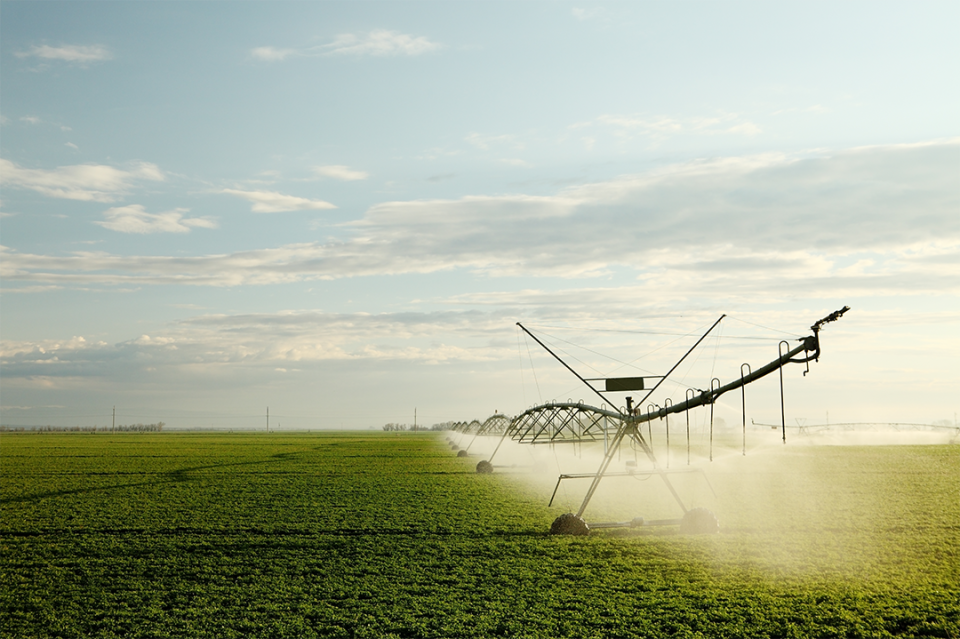
Pasture and Forage Minute: Early Season Irrigation, Controlling Alfalfa Weevil
Early Season Alfalfa Irrigation
By Todd WhitneyAlfalfa is a tough perennial with established rooting depths down eight feet or more. Depending on deep soil profile moisture, some varieties can extend spring dormancy and survive up to 45 days without rainfall. However, forage yields drop dramatically, since alfalfa requires about six inches of root available water to produce one ton of forage per acre.
So, what irrigation strategy is recommended for alfalfa during the early spring season prior to the first cutting? Remember that once perennial alfalfa plants experience moisture deficiency, soil moisture storage catch-up through irrigation is difficult, especially during the hot summer season due to high ET (evapotranspiration) water needs. Also, stressed plants may drop leaves prematurely; even if the alfalfa cutting is harvested before the recommended one-tenth bloom alfalfa development stage to salvage yield. This timing disruption may impact target irrigation just prior to the first cutting to increase regrowth tonnage for the succeeding crop.
Early season irrigation linked with first cutting alfalfa can potentially lower water use sharply, because transpiration is lower when the leaf foliage is removed. Following first cutting, irrigation might be delayed slightly in fields where weeds could respond quicker to the moisture than alfalfa regrowth.
Otherwise, full water irrigation or rainfall target amounts will be typically six to seven inches of water for each subsequent cutting. Spring water usage may only be one-fourth inch per day but will rapidly increase as summer temperatures rise. Peak water alfalfa usage in July and August can extend beyond the normal one-third inch per day (or two inches per week) to half inch per day during extreme stress times.
Alfalfa Weevil Control
By Samantha DanielWith the arrival of spring comes the impending return of insects, including pest species like the alfalfa weevil.
Plant injury from alfalfa weevil feeding damage appears as pinholes in the terminal leaves, with leaves becoming skeletonized as feeding severity increases. Adult beetles are roughly 5mm in length with a blunt snout and a brown body. Larvae are 1.5mm to 8.5mm long with a black head, wrinkled green body, and white stripe along the back and will curl into a C-shape when disturbed.
Scouting for alfalfa weevil up to and even during the first cutting can help to mitigate economic losses. First, use a sweep net to determine whether larvae are present. If they are, randomly select five sites across the field and collect 10 stems at each site, cutting the stems at ground level. Beat the stems into a deep-sided bucket and count the number of larvae to determine the average number per stem. While you are actively cutting your alfalfa field, take some time to inspect your equipment for larvae. Economic thresholds for alfalfa weevil can vary greatly from an average of one to seven larvae per stem, depending on a variety of factors. Threshold tables can be found here.
A variety of insecticides are labeled for alfalfa weevil control, including pyrethroids and products containing indoxacarb (such as Steward). Pyrethroids are more harmful to natural enemies of alfalfa weevil, while indoxacarb is more selective and may help to maintain beneficial insect populations. When alfalfa reaches 50% or more bud stage, it may be more profitable to cut the alfalfa early rather than treat it.
Spring Grazing to Control Weeds
By Jerry VoleskySpring flash grazing in pastures can be a way to capitalize on some of the early weeds that may be growing. For those areas in eastern Nebraska that had drought conditions in 2023, it is likely that many pastures will have more spring and summer weeds than usual this year.
Drought last year also has led to the general recommendation of delaying turn out to pasture, but early flash grazing can be an option to reduce growth of some of those weeds. Flash grazing is the process of quickly rotating through pastures early, before they are scheduled for their main summer grazing period.
When flash grazing mixed cool- and warm-season grass pastures, we do want to be a little more cautious as to not overgraze any desirable cool-season grasses. In areas where cheatgrass or downy brome is a problem, grazing at strategic windows — such as during the cheatgrass elongation phase right before seed set — appears to be the best time to apply grazing. Grazing at this time matches diet preference by grazing animals with the cheatgrass growth period and limits over use on perennial cool-season grasses growing at the same time. Targeted grazing is a long-term management option that can utilize cheatgrass as a forage resource and limit the potential seed proliferation within a system.
In warm-season grass pastures, an abundance of early weeds will remove moisture that could be used for grass growth later on and they remove valuable nutrients from the soil. Early weeds also can develop so much growth that they can shade, smother and reduce early growth of your summer pasture grasses.
While early flash grazing of some pastures will not eliminate all the weeds, it can actually make for some pretty timely and valuable pasture.
Online Master of Science in Agronomy
With a focus on industry applications and research, the online program is designed with maximum flexibility for today's working professionals.
